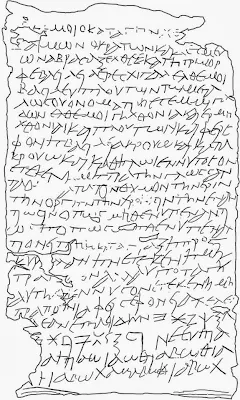Israel Antiquities
Authority archaeologists have excavated a 1,700-year-old curse tablet from a
Roman mansion in the City of David in Jerusalem. It was discovered in what was
a second-floor room in the northwest part of the mansion. In the tablet a woman
named Kyrilla curses a man named Ιennys, likely over a legal case. PHOTO
COURTESY ROBERT WALTER DANIEL
Η
«ρωμαϊκή» έπαυλη στην οποία βρέθηκε ο πάπυρος βρίσκεται στη λεγόμενη «Πόλη του
Δαυίδ», κατοικήθηκε στα τέλη του 3ου αιώνα και καταστράφηκε μετά από μία σειρά
σεισμών φέτος το Μάιο.
The text in the
curse tablet is written in Greek, a language often used in the eastern half of
the Roman Empire. In the text Kyrilla invokes six gods in her curse, the start
of the text reading (in translation): "come to me, you who are in the
earth, chthonic daemon, you who rule and bind…" Credit: Photo courtesy
Robert Walter Daniel, cropped by Owen Jarus
Το
κείμενο του αρχαίου εγγράφου είναι γραμμένο στα ελληνικά. Μία γυναίκα, ονόματι
Κυρίλλα επικαλείται τα ονόματα έξι θεών για να ρίξει κατάρα σε έναν άνδρα που
ονομάζεται Ιέννις, πιθανότατα εξαιτίας νομικής διαμάχης που είχαν μεταξύ τους.
The text also
includes magical signs that are seen here at the top of this image.
Additionally magical words were used to enhance the curse's power. Credit:
Photo courtesy Robert Walter Daniel, cropped by Owen Jarus
Η
Κυρίλλα ζητά από τους θεούς να εξασφαλίσουν ότι ο Ιέννις «σε καμία περίπτωση
δεν θα πει ή θα κάνει κάτι εναντίον της, αλλά θα την υπακούει πιστά…»
A drawing showing
the lettering of the curse tablet, which was discovered in a Roman mansion in
the City of David in Jerusalem. Credit: Photo courtesy Robert Walter Daniel
Για
να πιάσει η κατάρα, η Κυρίλλα συνδύασε στοιχεία από τέσσερις θρησκείες, σύμφωνα
με τον καθηγητή Ρόμπερτ Βάλτερ Ντάνιελ από το Πανεπιστήμιο της Κολωνίας.
Τέσσερις από τους έξι θεούς που επικαλείται είναι έλληνες (Ερμής, Περσεφόνη,
Πλούτωνας και Εκάτη), μία ήταν βαβυλώνια (Ερεσκιγκάλ) και ένας ανήκε στους Γνωστικούς
(Αβράσαξ), ένα προχριστιανικό φιλοσοφικό και θρησκευτικό κίνημα. Επιπλέον, το
κείμενο περιέχει και λέξεις εβραϊκής/ιουδαϊκής προέλευσης που χρησιμοποιούνταν
στη μαγεία όπως «laoth».
In their
excavations the archaeologists found artifacts that reveal the wealth the
inhabitants of the mansion enjoyed, including this gem depicting Cupid holding
a torch. Credit: Photo courtesy Israel Antiquities Authority
Οι
αρχαιολόγοι πιστεύουν ότι η κατάρα γράφτηκε από κάποιον μάγο, που πραγματικά
χρησιμοποίησε σφυρί και καρφιά για το τελετουργικό του, ώστε να ενισχύσει τη
δύναμη της κατάρας.
«Το
σφυροκόπημα και το κάρφωμα είναι ένας τρόπος για να αποκτήσει κάποιος έλεγχο
πάνω στο άτομο που αναφέρουν τα μαγικά κείμενα,» αναφέρει ο Ντάνιελ.
The City of David,
where the mansion is located, is an area of Jerusalem that contains at least
6,000 years of human occupation. This image shows ruins from the area dating
from different periods of time. Credit: Photo by Deror Avi CC Attribution
Share-Alike 3.0 Unported
Η
Κυρίλλα και ο αποδέκτης της κατάρας ανήκαν πιθανότητα στη μεσαία ή ανώτερη
αστική ρωμαϊκή τάξη και βρίσκονταν σε νομική διαμάχη, καθώς ο πάπυρος με την
κατάρα φέρει ομοιότητες με άλλους που βρέθηκαν στην Κύπρο και είναι γνωστό ότι
είχαν χρησιμοποιηθεί σε νομικές υποθέσεις. Επιπλέον, η λέξη «ανακοπή» που
αναφέρεται στο κείμενο, παραπέμπει σε νομικό θέμα.






